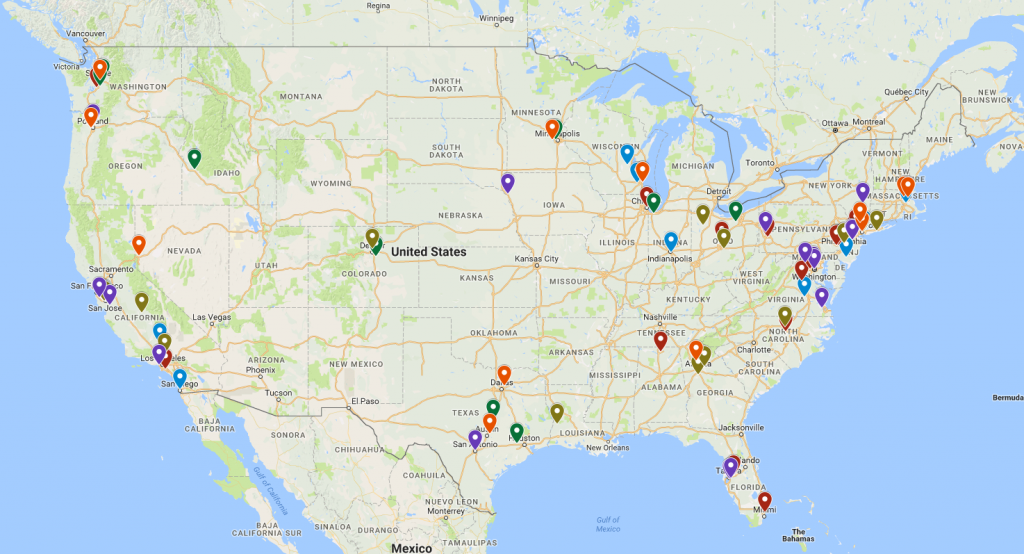The National STEM Video Game Challenge has motivated interest in science, technology, engineering, and math (STEM) in nearly 20,000 middle and high school students since launching in 2011 by harnessing their natural passion for playing video games and inspiring them to design games of their own.
Presented by the Joan Ganz Cooney Center at Sesame Workshop and E-Line Media with founding sponsor the Entertainment Software Association (ESA), the STEM Challenge has named 113 youth winners – including 40% female – from 25 states and 80 cities over the course of six competition cycles (see map below). Over $500,000 in prizes has been awarded to winners and supporting institutions, and seven winners showcased their games at a White House Science Fair. Additionally, hundreds of youth and mentor game design workshops were held nationally.

Winners of the 2017 National STEM Video Game Challenge were honored as part of a panel on The Youth-to-Industry Pipeline: How Challenges & Game Jams Create Career Pathways at the 2017 Games for Change Festival in New York City on July 31, 2017. The winning games were also on display in the Marketplace for attendees to play.
Michael Levine, Founding Executive Director, Joan Ganz Cooney Center at Sesame Workshop, announced the names of all 23 winners middle and high school winners of the 2017 competition cycle and premiered the Meet the 2017 National STEM Video Game Challenge Winners video. Winning games were identified in 14 categories including GameMaker, Gamestar Mechanic, Open Platform – Individual, Open Platform – Team, Scratch, Unity, Written Game Design Document, and Games for Change.
This year’s winners reflect an exceptionally talented group. Five of the winners – Lucas Armand, John Korhel, John Ripple, Shrey Pandya, and Connor Shugg – were previous STEM Challenge winners. Other winners have participated and won related competitions such as the Congressional App Challenge and the Verizon Innovative Learning app challenge.
For the first time in STEM Challenge history, one school – Milwaukee Montessori – yielded two winners in two different categories during the same competition cycle – Himani Chonkar for Written Game Design Document and Zoe Plunkett for Scratch Middle School, a fact made more impressive in that the same school produced a previous STEM Challenge winner in 2012.
Following the announcement of the winners, Olivia Thomas spoke about how her participation and win in the 2014-15 STEM Challenge led her to pursue a double major in computer science and GIMM (Games, Interactive Media, and Mobile Development) at Boise State University.
Next up was Sara Cornish, Senior Director, Programs & Strategy, Games for Change, who announced the winners of the 2017 National Games for Change Student Challenge and then introduced high school student Geneva Heyward to share her perspective. Not only was Geneva the Grand Prize Winner in the 2017 Games for Change Student Challenge, but she was also the winner of the 2017 STEM Challenge Unity category.

Shifting the focus from students to organizations, Susanna Pollack, President, Games for Change, serving as a moderator opened the discussion and question-and-answer session about how game making competitions, hackathons, and game jams inspire youth to level up from players to developers; build 21st century skills like coding, computational thinking, and system design; and pursue college and industry pathways. Joining Susanna and me on the panel were Marc Lesser, Senior Director, Learning Design, Mouse; Ani Martinez, Community Manager, Remake Learning; and Kevin O’Hanlon, Director, Federal Government Affairs, ESA.

In the seven years since the STEM Challenge was first announced at the White House by President Obama as part of the “Educate to Innovate” initiative, we’re thrilled that many other opportunities in the larger ecosystem have emerged to inspire and motivate youth. Now that the sixth and final STEM Challenge competition has concluded, we hope that middle and high school students will consider entering one of the other competitions, such as the National Games for Change Students Challenge, the Scholastic Art & Writing Awards (video game design category), and the Technovation Challenge.
The STEM Challenge is thankful for our many sponsors over the years, including AARP/Mentor Up, AMD Foundation, Bayer, Games for Change, the Grable Foundation, Hive Digital Learning Fund in The New York Community Trust, Institute of Museum and Library Services (IMLS), Microsoft, National Geographic Society, and the Smithsonian.
We’re also appreciative of the efforts of all of our national outreach partners over the years. Partners have included the American Library Association, BELL, Boys & Girls Clubs of America, BrainPOP, #BUILTBYGIRLS, Corporation for Public Broadcasting/PBS KIDS Ready to Learn, Edmodo, Empow Studios, Girls Scouts of the USA, Global Kids, International Game Developers Association, Learning Games Network, Mozilla Hive NYC Learning Network, Urban Tech, Vsauce, and Youth Digital.
A final shout-out to all the teachers, librarians, mentors, parents, workshop hosts, expert judges, and STEM Challenge friends who have partnered with us. Together we share a passion for building out STEM pathways and we are excited to see what the future holds for our emerging game makers.
 Mark German is President, E-Line Education at E-Line Media. In addition to managing the STEM Challenge for the last three competition cycles, Mark oversees the educational services division offering learning pathways delivered through game-based programs that empower youth to understand and shape their world.
Mark German is President, E-Line Education at E-Line Media. In addition to managing the STEM Challenge for the last three competition cycles, Mark oversees the educational services division offering learning pathways delivered through game-based programs that empower youth to understand and shape their world.

